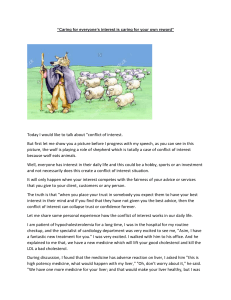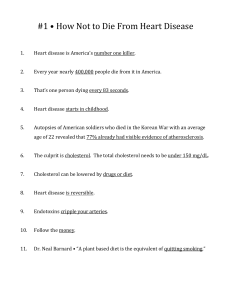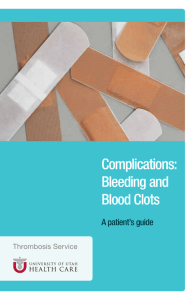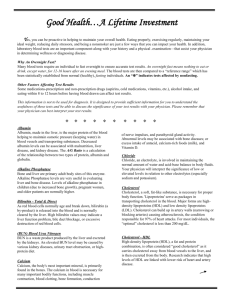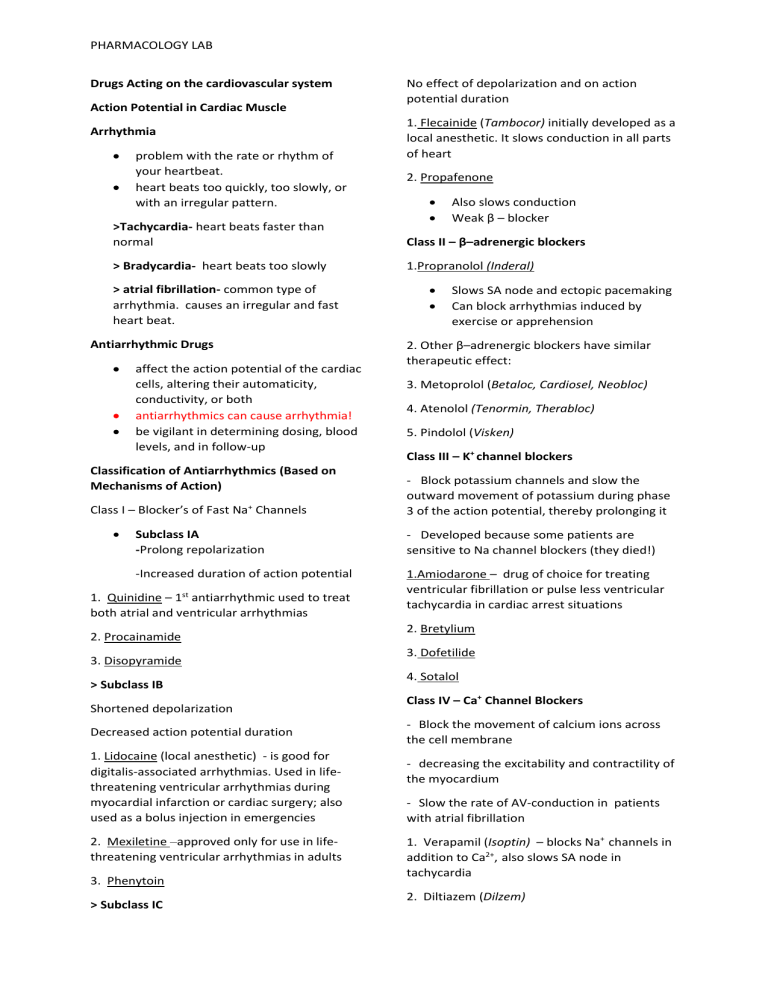
PHARMACOLOGY LAB Drugs Acting on the cardiovascular system Action Potential in Cardiac Muscle Arrhythmia problem with the rate or rhythm of your heartbeat. heart beats too quickly, too slowly, or with an irregular pattern. No effect of depolarization and on action potential duration 1. Flecainide (Tambocor) initially developed as a local anesthetic. It slows conduction in all parts of heart 2. Propafenone Also slows conduction Weak β – blocker >Tachycardia- heart beats faster than normal Class II – β–adrenergic blockers > Bradycardia- heart beats too slowly 1.Propranolol (Inderal) > atrial fibrillation- common type of arrhythmia. causes an irregular and fast heart beat. Antiarrhythmic Drugs affect the action potential of the cardiac cells, altering their automaticity, conductivity, or both antiarrhythmics can cause arrhythmia! be vigilant in determining dosing, blood levels, and in follow-up Classification of Antiarrhythmics (Based on Mechanisms of Action) Class I – Blocker’s of Fast Na+ Channels Slows SA node and ectopic pacemaking Can block arrhythmias induced by exercise or apprehension 2. Other β–adrenergic blockers have similar therapeutic effect: 3. Metoprolol (Betaloc, Cardiosel, Neobloc) 4. Atenolol (Tenormin, Therabloc) 5. Pindolol (Visken) Class III – K+ channel blockers - Block potassium channels and slow the outward movement of potassium during phase 3 of the action potential, thereby prolonging it Subclass IA -Prolong repolarization - Developed because some patients are sensitive to Na channel blockers (they died!) -Increased duration of action potential 1.Amiodarone – drug of choice for treating ventricular fibrillation or pulse less ventricular tachycardia in cardiac arrest situations 1. Quinidine – 1st antiarrhythmic used to treat both atrial and ventricular arrhythmias 2. Procainamide 3. Disopyramide > Subclass IB Shortened depolarization Decreased action potential duration 1. Lidocaine (local anesthetic) - is good for digitalis-associated arrhythmias. Used in lifethreatening ventricular arrhythmias during myocardial infarction or cardiac surgery; also used as a bolus injection in emergencies 2. Mexiletine –approved only for use in lifethreatening ventricular arrhythmias in adults 3. Phenytoin > Subclass IC 2. Bretylium 3. Dofetilide 4. Sotalol Class IV – Ca+ Channel Blockers - Block the movement of calcium ions across the cell membrane - decreasing the excitability and contractility of the myocardium - Slow the rate of AV-conduction in patients with atrial fibrillation 1. Verapamil (Isoptin) – blocks Na+ channels in addition to Ca2+, also slows SA node in tachycardia 2. Diltiazem (Dilzem) PHARMACOLOGY LAB -There is a risk of severe cardiac effects if these drugs are given IV within 48 hours of IV betaadrenergic drugs. Nursing Implementation 1. Titrate the dose to the smallest amount needed to decrease the risk of severe adverse effects. 2. Continually monitor cardiac rhythm when initiating or changing dose to detect potentially serious adverse. 3. Ensure that emergency life support equipment is readily available. 4. Administer parenteral forms as ordered only if the oral form is not feasible. 5. Consult with the prescriber to reduce the dose in patients with renal or hepatic dysfunction -reduced dose may be needed to ensure therapeutic effects without increased risk of toxic effects. 6. Establish safety precautions, including side rails, lighting, and noise control. 7. Arrange for periodic monitoring of cardiac rhythm when the patient is receiving long-term therapy to evaluate effects on cardiac status. - The most common etiology of coronary artery disease (CAD) in adults is atherosclerosis, the presence of plaque – a fatty, fibrous material within the walls of the coronary arteries. - Plaque develops progressively over time, producing varying degrees of intravascular narrowing, and a situation that results in partial or total blockage of the vessel. > These drugs can work to improve blood delivery to the heart muscle in one of two ways: 1. By dilating blood vessels ( increasing the supply of oxygen) 2. By decreasing the work of the heart (decreasing the demand for oxygen) Anti-Angina Drugs come in many different forms: 1. tablets and capsules that are swallowed; 2. tablets that are held under the tongue, inside the lip, or in the cheek until they dissolve; 3. stick-on patches; and sprays Nitrates Antianginal Drugs What is Angina? > Increase demand of 02 > Decrease 02 supply - Coronary Artery Disease (CAD) is characterized by narrowing or occlusion of a coronary artery. - The narrowing deprived cells of oxygen and nutrients, also known as myocardial ischemia. - If ischemia develops over a long period of time, the heart may compensate for its inadequate blood supply, and the client may experience no symptoms. - As CAD progresses, the myocardium does not receive enough oxygen to meet the metabolic demands of the heart, and symptoms of angina begin to appear. -Persistent myocardial ischemia may lead to heart attack. act directly on smooth muscle to cause relaxation and to depress muscle tone. the action is direct, these drugs do not influence any nerve or other activity, and the response is usually quite fast. Also termed as vasodilators Commonly used Anti-Angina Drugs Isosorbide dinitrate (Isordil) Isosorbide mononitrate (Imdur) Nitroglycerin (Nitrostat, Nitro-Bid) Adverse Effects CNS: Headache, dizziness, weakness GI: Nausea, vomiting, incontinence Cardiovascular: Hypotension which can be severe and must be monitored; -reflex tachycardia that occurs when blood pressure falls; -syncope and angina which could be exacerbated by the hypotension and changes in cardiac output PHARMACOLOGY LAB Sublingual usual protocol for administering nitroglycerin tablets administer one tablet every 5 minutes as needed total dose of three tablets Onset of action is within 1-3 minutes duration of action is 30-60 minutes Nursing Interventions 1. Give sublingual preparations under the tongue or the buccal pouch. 2. Offer sips of water before giving sublingual nitroglycerin because dryness may inhibit drug absorption 3. Ask the patient if the tablet “fizzles” or burns, which indicates potency. protect the medication from heat and light. 4. Instruct the patient that a sublingual dose may be repeated in 5 minutes if relief is not felt, for a total of 3 doses; if pain persists, the patient should go to an emergency room to ensure proper medical support if an MI occur. Transdermal Patch • Wash hands thoroughly before and after applying. • Apply the patch to the chest, inner side of the upper arm, or shoulder. • Clean and dry the skin before applying the patch. If necessary, hair may be removed. • Change the treatment site daily. Do not apply to irritated or damaged skin • If the patch becomes loose, remove it and apply a new patch at a different site. • • After you remove the used patch, fold the sticky side together and throw away. Should only be worn for up to 12 to 14 hours a day, or as directed by your doctor so that the client will have a 10 to 12 hour "nitrate-free" period each day. This will prevent client tolerance to nitrates. Lipid Lowering Agents Antihyperlipidemics LIPIDS Cholesterol and other fatty acids not soluble in liquid they are carried in the plasma by linking lipoproteins (albumins and globulins). Lipoproteins- described by how thick and dense they are (“high density lipids” and “low-density lipids”) The body needs a certain amount of cholesterol and triglycerides Four Major Types of Lipoprotiens 1. Chylomicrons -largest and lightest of the lipoproteins. -Formed from the absorption of dietary fat in the intestine and are mostly triglycerides. -Normally present in plasma for only 1 to 8 hours after the last meal. 2. Very low-density lipoproteins (VLDLs) made up of large amounts of triglycerides that were made in the liver 3. Low-density lipoproteins (LDLs). When VLDLs break down and link with cholesterol and protein, very little triglyceride is left. High serum levels of LDLs indicate cholesterol levels that are higher than the body needs. Paients with high LDL levels are at high risk for developing atherosclerosis. 4. High-density lipoproteins (HDLs) are small, dense lipoproteins and contain very small parts of triglycerides. The “vacuum cleaners” of the tissues, clearing out excess cholesterol. Chylomicrons and VLDLs are seen as triglyceride-rich lipoproteins LDLs and HDLs are cholesterol-rich lipoproteins LDLs move cholesterol from the liver to the peripheral tissues HDLs remove cholesterol from the periphery and transport it to the liver Hyperlipidemia used to describe an increase in levels of lipoproteins in the blood. PHARMACOLOGY LAB It leads to atherosclerosis and patients with damage to the lining of their vascular walls have a gradual build up of fatty deposits within the lining of the vessel walls of the arterial system. This will lead to the onset of angina that results from ischemic heart disease, cerebrovascular disease, peripheral ischemia, and renovascular hypertension. Types of Antihyperlipidemic Drugs 1. Bile Acid Sequestrants 2. HMG – CoA ( hydroxymethylglutartyl – CoEnzyme A)Reductase Inhibitors 3. Fibric acid derivatives 4. Niacin Bile Acid Sequestrant Cholestyramine (Questran) Colestipol (Colestid) • Reduce serum cholesterol levels by forming an insoluble compounds with bile salts and increasing bile loss through the feces. • This results in decrease LDL plasma levels of at least 20% and serum cholesterol levels • no longer considered first-line drugs for dyslipidemia Side Effects: Bloating, Constipation, Abdominal pain, Nausea, Vomiting, Diarrhea, Steatorrhea or excessive fat in the stool. Nursing Implementation 1. Do not administer powdered agents in dry form. Mix with fruit juices, soups, liquids, cereals, or pulpy fruits. Do not mix cholestyramine, with carbonated beverages. Encourage the patient to swallow all of the dose. 2. Ensure that tablets are not cut, chewed, or crushed because they are designed to be broken down in the GI tract 3. Administer other oral medications 1 hour or 4 hours after taking bile acid sequestrants to avoid interference of other drugs. 4. Arrange for a bowel program as appropriate to effectively deal with constipation if it occurs. 5. Inform client to follow a high-bulk diet and drink lots of fluids. 6. Advise client to immediately report yellowing of the skin or eyes to evaluate possible adverse effects HMG-CoA Reductase Inhibitors 1. Simvastatin ( Zocor) for lowering cholesterol and preventing MI in patients with known hypercholesterolemia and CAD 2. Atorvastatin (Lipitor) associated with severe liver complications but can be used to lower cholesterol levels in children 10 to 17 years of age 3. Rosuvastatin (Crestor) the newest statin and lowers LDL and raise HDL slightly better than the other statins Statins should be administered in the evening because cholesterol biosynthesis in the body is higher at night Minor side effects include headache, fatigue, muscle or joint pain Serious adverse effects are severe myopathy and rhabdomyolysis. Liver dysfunction may occur with the use of statin drugs, monitor liver function tests before and during the first few months of therapy Statin drugs should not be used in clients with active liver disease or unexplained elevations in liver function tests Nursing Implementation 1. Administer the drug at bedtime because the highest rates of cholesterol synthesis occur between midnight and 5 AM, - drug should be taken when it will be most effective; but atorvastatin PHARMACOLOGY LAB can be given at any time during the day 2. Monitor serum cholesterol and LDL levels before and periodically during therapy to evaluate the effectiveness of the drug. 3. Monitor liver function tests before and periodically during therapy - consult with the prescriber to discontinue the drug if the aspartate aminotransferase (AST) or alanine aminotransferase (ALT) level increases to three times normal. 4. Ensure that the patient has attempted a cholesterol lowering diet and exercise program for at least 3 to 6 months before beginning therapy to ensure the need for drug therapy. 5. Withhold lovastatin, atorvastatin, or fluvastatin in any acute, serious medical condition (e.g., infection, hypotension, major surgery or trauma, metabolic endocrine disorders, seizures) that might suggest myopathy or serve as a risk factor for the development of renal failure. 6. Suggest the use of barrier contraceptives for women of childbearing age because there is a risk of severe fetal abnormalities if these drugs are taken during pregnancy. 7. Arrange for periodic ophthalmic examinations to monitor for cataract development. 8. Provide comfort measures. These include small, frequent meals to minimize nausea and vomiting -access to bathroom facilities to ensure adequate bowel evacuation; -give food if GI upset is severe to decrease direct irritating effects; - temperature and lighting controls, to help deal with headaches; -activity restrictions, to protect the patient if vision changes and muscle effects occur. Fibric acid derivatives 1. Ezetimibe (Ezetrol, Vytorin) decreasing the absorption of dietary cholesterol, leading to a drop in serum cholesterol levels. 2. Fenofibrate (Lipanthyl) inhibits triglyceride synthesis in the liver, resulting in reduction of LDL levels 3. Gemfibrozil (Lopid) inhibits peripheral breakdown of lipids, reduces production of triglycerides and LDLs and increases HDL concentration. -Fenofibrate and Gemfibrozil are well tolerated but can cause liver toxicity and cholelithiasis (gallstones) Niacin (Vitamin B3 ) • One of the most effective antihyperlipidemics at lowering triglyceride levels and increasing HDL levels. • Similar to bile acid sequestrants in its ability to lower LDL levels. • Adverse effect: flushing, which occurs shortly after the drug is taken and can be reduced by taking aspirin (30 minutes before) and increasing the niacin dosage very slowly over 3 to 4 weeks. Client Teaching for Antihyperlipidemic Drugs 1. Teach client to take vitamins A, D, and K as supplements if antihyperlipidemic drugs are to be taken for long period of time. 2. bile acid sequestrants are to be taken 3x a day before meals. 3. Instruct client that bile acid sequestrants come as a powder and should be added to a liquid. Allowing the power to dissolve slowly without stirring. 4. Instruct patients to take any other medicine 1 hour before or 4 to 6 hours after taking antihyperlipidemics since these medicines are like glue and will delay the absorption of other drugs if taken at the same time. PHARMACOLOGY LAB Drugs for Coagulation Disorders The three major groups are Blood Clot Formation (1) anticoagulants, • (2) antiplatelet, Hemostasis, or the stopping of blood flow and is an essential mechanism that protects the body from both external and internal injury. (3) thrombolytics Anticoagulants • Without efficient hemostasis, bleeding from wounds or internal injuries would lead to shock and perhaps death • Drugs used to prolong bleeding time and thereby prevent blood clots from forming • Hemostasis is a complex process involving a number of clotting factors that are activated in a series of sequential steps, sometimes referred to as a cascade • Also called as blood thinners • Do not dissolve clots that have already formed, but rather act prophylactically to prevent new clots from forming • Used in patients with venous and arterial disorders that put them at high risk for clot formation • Venous problems such as thrombosis, pulmonary embolism, & arterial problems like coronary thrombosis, and MI • Contraindicated with active bleeding, except for DIC, bleeding disorders, or blood dyscracias, ulcers, liver and kidney disease • Side effects: hemorrhage, hematuria, epistaxis, ecchymosis, bleeding gums, thrombocytopenia • Too much clotting can be just as dangerous • Diseases can affect hemostasis like MI, cerebrovascular accident (CVA), venous thrombus, valvular heart disease 4 Steps to Hemostasis - - - 1. Vessel injury 2. Vessel Spasm 3. Platelets adhere to injury site and aggregate to form plug 4. Formation of insoluble fibrin strands and coagulation. Hemostasis is achieved once a blood clot is formed, protecting the body from excessive hemorrhage The clot may restrict blood flow to the affected area; circulation must eventually be restored so that the tissue can resume normal activities The process of clot removal is called fibrinolysis. It is initiated within 24 to 48 hours of clot formation and continues until the clot is dissolved Disorders that directly affect the coagulation process fall into two main categories: Warfarin (Coumadin) • Oral drug • Works by interfering with the formation of vitamin K-dependent clotting factors in the liver Vitamin K is used to reverse the effects of warfarin. Coumadin 1. conditions that involve overproduction of clots, or thromboembolic disorders; 2. conditions in which the clotting process is not working effectively, resulting in risk for excess bleeding or hemorrhagic disorders. -Various drugs are used to maintain or restore circulation • A longer than normal prothrombin time (PT) can mean a lack of or low level of PHARMACOLOGY LAB one or more blood clotting factors (factors I, II, V, VII, or X). • It can also mean a lack of vitamin K or due liver disease, such as cirrhosis; or that a liver injury has occurred • It can be due to Disseminated Intravascular Coagulation (DIC) • It can also be caused by treatment with blood-thinning medicines, such as warfarin (Coumadin) or, in rare cases, heparin. Anticoagulants • Dabigatran (Pradaxa) directly inhibits thrombin, which blocks the last step to clot formation It is approved to reduce the risk of stroke and systemic embolism in patients with nonvalvular atrial fibrillation (AF) Drug of choice over warfarin for treating this condition • Rivaroxaban (Xarelto) is a factor Xa inhibitor that stops the coagulation cascade at this early step. Approved to prevent deep vein thrombosis, which might lead to pulmonary embolism, in patients undergoing knee or hip replacement surgery. Heparin Heparin is a naturally occurring substance that inhibits the conversion of prothrombin to thrombin, thus blocking the conversion of fibrinogen to fibrin – the final step in clot formation Injected IV or subcutaneously and has an immediate onset of action Low molecular weight heparin like Enoxaparin given subcutaneously do not require the same intense monitoring like heparin The activated partial thromboplastin time (aPTT)) is a screening test that helps evaluate a person's ability to appropriately form blood clots. It measures the number of seconds it takes for a clot to form in a sample of blood. The aPTT assesses the amount and the function of certain proteins in the blood called coagulation or clotting factors. Nursing Implementation 1. Evaluate for therapeutic effects of warfarin like the prothrombin time (PT) 1.5 to 2.5 times the control value or ratio of PT to International Normalized Ratio (INR) of 2 to 3 to evaluate the effectiveness of the drug dose. 2. Evaluate for therapeutic effects of heparin like the activated partial thromboplastin time which is 1.5 to 3 times the control value to evaluate the effectiveness of the drug dose. 3. Evaluate the patient regularly for any sign of blood loss like petechiae, bleeding gums, bruises, dark-colored stools, dark-colored urine 4. Provide safety measures, such as use of an electric razor and avoidance of contact sports to decrease the risk of bleeding. 5. Provide increased precautions against bleeding during invasive procedures; use of pressure dressings; avoid IM injections; and do not rub subcutenous injection sites Thrombolytic Medications Therefore, it saves laboratory costs as well as nursing time Protamine sulfate is the antidote for heparin overdose Process of Fibrinolysis PHARMACOLOGY LAB Thrombolytic Medications • • • • • • The general action of thrombolytic agents is the selective degradation of formed fibrin clots with minimal effect on clot formation. Administered for disorders in which an intravascular clot has already formed such as in acute myocardial infarction, pulmonary embolism, acute ischemic cerebrovascular accident (CVA), and deep vein thrombosis (DVT ) Used early in the course of myocardial infarction within 4 to 6 hours of the onset of the infarct to restore blood flow This time limitation is not related to drug activity, because thrombolytic agents can break down clots older than 6 hours. Rather, tissue that has been anoxic for more than 6 hours is not likely to benefit from this therapy, making the risks to the client greater than the advantages. The goal of thrombolytic therapy is to quickly restore blood flow to the tissue served by the blocked vessel. Contraindications: active internal bleeding, history of CVA, intracranial problems, trauma within the previous 2 months Alteplase • If administered within 3 hours of onset of ischemic stroke, significantly improves clinical outcomes especially the patient’s ability to perform activities of daily living • Adverse effects: Bleeding complications including GI and cerebral hemorrhages Streptokinase • Therapy is instituted within 4 hours of myocardial infarction and is infused for one hour • Thromboplastin time is monitored and maintained at 2-5 fold the control value 4. Fondaparinux (Arixtra) a specific blocker of factor Xa for the prevention of venous thromboembolic events in patients undergoing surgery for hip fracture, hip or knee replacement. Antidote: Aminocaprioc acid (Amicar) Antiplatelet Medications THROMBUS: is the clot that adheres to the vessel wall EMBOLUS: is the CLOT that floats in the blood THROMBOSIS: is the formation of unwanted clot within the blood vessel, producing life threatening conditions such as: • Acute myocardial infarction • Acute ischemic stroke • Deep vein thrombosis • Pulmonary embolism Antiplatelet Medications • Inhibit the aggregation of platelets in the clotting process, thereby prolonging bleeding time • Used in the prophylaxis of long-term complications following MI and CVA • Contraindicated in bleeding disorders and known sensitivity • Side effects: GI bleeding, bruising, hematuria, tarry stools 1. clopidogrel (Plavix) - used in patients who are at risk for ischemic events and those with a history of MI 2. cilostazol (Pletaal) - indicated for the reduction of symptoms of intermittent claudication, allowing increased walking distance 3. acetlysalicylic acid (Aspirin) - is effective in decreasing incidence of Transient Ischemic Attack (TIAs) Adverse Effects • Most common adverse effect is bleeding, which often occurs as increased bruising and bleeding while brushing the teeth. • Headache • Dizziness • Weakness • Nausea PHARMACOLOGY LAB • GI distress Adverse Effects of Aspirin • Nausea • Dyspepsia • Heartburn • Epigastric discomfort • GI bleeding • Occult blood loss • Dizziness • Tinnitus • Difficulty hearing Nursing Interventions 1. Suggest safety measures, including the use of an electric razor and avoidance of contact sports. 2. Provide increased precautions against bleeding during invasive procedures; use pressure dressings and ice to decrease excessive blood loss caused by anticoagulants. 3. Provide small frequent meals to relieve GI discomfort

